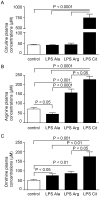Citrulline a more suitable substrate than arginine to restore NO production and the microcirculation during endotoxemia
- PMID: 22666356
- PMCID: PMC3362574
- DOI: 10.1371/journal.pone.0037439
Citrulline a more suitable substrate than arginine to restore NO production and the microcirculation during endotoxemia
Abstract
Background: Impaired microcirculation during endotoxemia correlates with a disturbed arginine-nitric oxide (NO) metabolism and is associated with deteriorating organ function. Improving the organ perfusion in endotoxemia, as often seen in patients with severe infection or systemic inflammatory response syndrome (SIRS) is, therefore, an important therapeutic target. We hypothesized that supplementation of the arginine precursor citrulline rather than arginine would specifically increase eNOS-induced intracellular NO production and thereby improve the microcirculation during endotoxemia.
Methodology/principal findings: To study the effects of L-Citrulline and L-Arginine supplementation on jejunal microcirculation, intracellular arginine availability and NO production in a non-lethal prolonged endotoxemia model in mice. C57/Bl6 mice received an 18 hrs intravenous infusion of endotoxin (LPS, 0.4 µg • g bodyweight(-1) • h(-1)), combined with either L-Citrulline (6.25 mg • h-1), L-Arginine (6.25 mg • h(-1)), or L-Alanine (isonitrogenous control; 12.5 mg • h(-1)) during the last 6 hrs. The control group received an 18 hrs sterile saline infusion combined with L-Alanine or L-Citrulline during the last 6 hrs. The microcirculation was evaluated at the end of the infusion period using sidestream dark-field imaging of jejunal villi. Plasma and jejunal tissue amino-acid concentrations were measured by HPLC, NO tissue concentrations by electron-spin resonance spectroscopy and NOS protein concentrations using Western blot.
Conclusion/significance: L-Citrulline supplementation during endotoxemia positively influenced the intestinal microvascular perfusion compared to L-Arginine-supplemented and control endotoxemic mice. L-Citrulline supplementation increased plasma and tissue concentrations of arginine and citrulline, and restored intracellular NO production in the intestine. L-Arginine supplementation did not increase the intracellular arginine availability. Jejunal tissues in the L-Citrulline-supplemented group showed, compared to the endotoxemic and L-Arginine-supplemented endotoxemic group, an increase in degree of phosphorylation of eNOS (Ser 1177) and a decrease in iNOS protein level. In conclusion, L-Citrulline supplementation during endotoxemia and not L-Arginine reduced intestinal microcirculatory dysfunction and increased intracellular NO production, likely via increased intracellular citrulline and arginine availability.
Conflict of interest statement
Figures






Similar articles
-
Microcirculatory Function during Endotoxemia-A Functional Citrulline-Arginine-NO Pathway and NOS3 Complex Is Essential to Maintain the Microcirculation.Int J Mol Sci. 2021 Nov 3;22(21):11940. doi: 10.3390/ijms222111940. Int J Mol Sci. 2021. PMID: 34769369 Free PMC article.
-
Arginase-1 deficiency regulates arginine concentrations and NOS2-mediated NO production during endotoxemia.PLoS One. 2014 Jan 21;9(1):e86135. doi: 10.1371/journal.pone.0086135. eCollection 2014. PLoS One. 2014. PMID: 24465919 Free PMC article.
-
Citrulline Supplementation Improves Organ Perfusion and Arginine Availability under Conditions with Enhanced Arginase Activity.Nutrients. 2015 Jun 29;7(7):5217-38. doi: 10.3390/nu7075217. Nutrients. 2015. PMID: 26132994 Free PMC article.
-
Influence of L-citrulline and watermelon supplementation on vascular function and exercise performance.Curr Opin Clin Nutr Metab Care. 2017 Jan;20(1):92-98. doi: 10.1097/MCO.0000000000000340. Curr Opin Clin Nutr Metab Care. 2017. PMID: 27749691 Review.
-
Arginine and citrulline and the immune response in sepsis.Nutrients. 2015 Feb 18;7(3):1426-63. doi: 10.3390/nu7031426. Nutrients. 2015. PMID: 25699985 Free PMC article. Review.
Cited by
-
Oral citrulline supplementation protects female mice from the development of non-alcoholic fatty liver disease (NAFLD).Eur J Nutr. 2017 Dec;56(8):2519-2527. doi: 10.1007/s00394-016-1287-9. Epub 2016 Aug 5. Eur J Nutr. 2017. PMID: 27496089
-
Supplementary Nitric Oxide Donors and Exercise as Potential Means to Improve Vascular Health in People with Type 1 Diabetes: Yes to NO?Nutrients. 2019 Jul 12;11(7):1571. doi: 10.3390/nu11071571. Nutrients. 2019. PMID: 31336832 Free PMC article. Review.
-
Potential Implications of Citrulline and Quercetin on Gut Functioning of Monogastric Animals and Humans: A Comprehensive Review.Nutrients. 2021 Oct 25;13(11):3782. doi: 10.3390/nu13113782. Nutrients. 2021. PMID: 34836037 Free PMC article. Review.
-
Supplemental Citrulline Is More Efficient Than Arginine in Increasing Systemic Arginine Availability in Mice.J Nutr. 2017 Apr;147(4):596-602. doi: 10.3945/jn.116.240382. Epub 2017 Feb 8. J Nutr. 2017. PMID: 28179487 Free PMC article.
-
Global trend and future landscape of intestinal microcirculation research from 2000 to 2021: A scientometric study.World J Gastroenterol. 2023 Mar 7;29(9):1523-1535. doi: 10.3748/wjg.v29.i9.1523. World J Gastroenterol. 2023. PMID: 36998427 Free PMC article.
References
-
- Ince C. The microcirculation unveiled. Am J Respir Crit Care Med. 2002;166:1–2. - PubMed
-
- Crouser ED, Julian MW, Dorinsky PM. Ileal VO(2)-O(2) alterations induced by endotoxin correlate with severity of mitochondrial injury. Am J Respir Crit Care Med. 1999;160:1347–1353. - PubMed
-
- Krejci V, Hiltebrand LB, Erni D, Sigurdsson GH. Endothelin receptor antagonist bosentan improves microcirculatory blood flow in splanchnic organs in septic shock. Crit Care Med. 2003;31:203–210. - PubMed
Publication types
MeSH terms
Substances
LinkOut - more resources
Full Text Sources
Other Literature Sources
Medical

